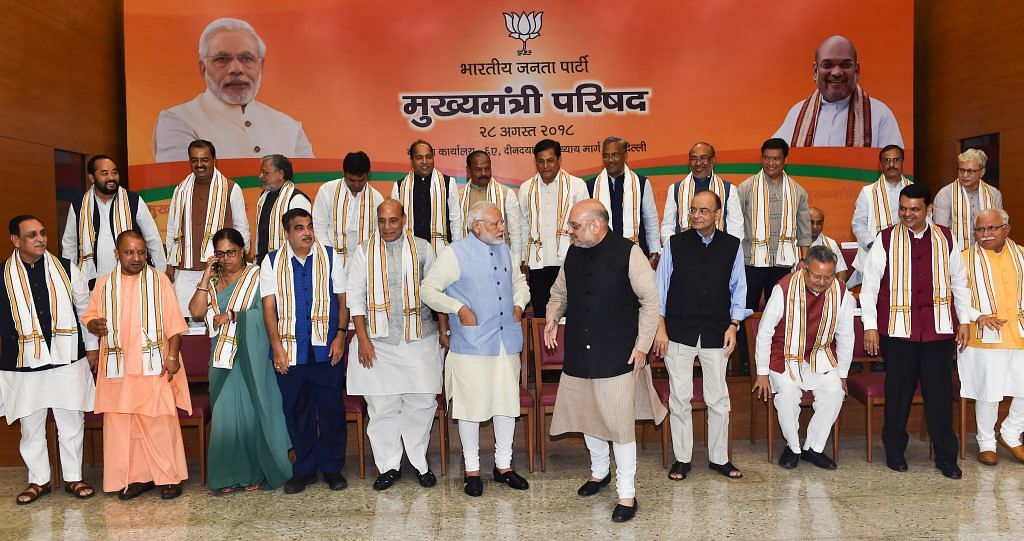Narendra Modi has beat BJP CMs Vasundhara Raje, Shivraj Singh Chouhan and Raman Singh in one key area.
The ‘maharani’, the ‘mamaji’ and the ‘chawal waale baba’ have a difficult month ahead in the state elections in Rajasthan, Madhya Pradesh and Chhattisgarh.
Three incumbent Bharatiya Janata Party (BJP) chief ministers and very distinct leaders – Rajasthan’s Vasundhara Raje, Shivraj Singh Chouhan of Madhya Pradesh and Chhattisgarh’s Raman Singh – have much at stake as they face a grilling election and grapple with the shared formidable challenge of anti-incumbency.
But each of their individual branding is unique and the monikers they have come to acquire best define their politics.
The maharani
The ‘queen’ image of Raje, 65, isn’t merely because of her royal roots.
The perception of her being a hubristic, unapproachable and aloof politician has earned her what in politics is a rather unsavoury moniker. Among the three BJP chief ministers, she is the one struggling the most, despite the fact that the other two are defending three terms compared to her one.
Most successful chief ministers in the country have a certain genre of politics that defines them, which connects with the voter at some level.
Also read: State elections are bad news for BJP and not good news for Congress either
But Raje’s deep unpopularity in the state and complete inability to even put up a spirited fight is only reflective of her not having invested in a political persona that has mass resonance.
The leader was not particularly popular even by the end of her earlier tenure (2003-2008), but managed a win under the ‘Modi wave’ in 2013.
But Raje’s strength is that she has a hold over the state’s party organisation. Even the all-powerful BJP president has had to give in to her on several occasions — including the appointment of the Rajasthan BJP president and ticket distribution ahead of the polls.
The party could not afford to replace her as its face in the state, despite knowing well a fresh face would have helped salvage its situation to an extent.
In terms of perception as well, Raje is unapologetic. The chiffon-clad leader conforms neither to the stereotype of a khadi-saree wearing politician like Maneka Gandhi, the bharatiya naari version like Sushma Swaraj, or the saffron-clad one like Uma Bharti.
She doesn’t have a signature issue or narrative or slogan that defines her politics. She does not quite adapt to changing times, leave alone connecting with the voter.
Like a maharani, she has her durbar – the party’s organisation in the state. This makes her a paradoxical mix, disconnected with the electorate but with a grip over her cadres.
The mamaji
Shivraj Singh Chouhan, 59, might be up against a three-term anti-incumbency, but even his worst critics acknowledge his popularity.
Among the three chief minister, Chouhan is the one with the deepest grassroots connect with the Rashtriya Swayamsevak Sangh (RSS), and his conduct is influenced by the Sangh.
The most definitive aspect of his politics has been his connect with the woman voter. The string of initiatives launched by him, including the Ladli Laxmi Yojana, distribution of cycles to girls, and the Kanya Vivah Scheme, is what earned him the title mamaji.
Also read: In Madhya Pradesh, Narendra Modi ko gussa kyon aata hai
Chouhan, an OBC leader, also built his politics on a direct line with this socially and electorally important constituency, besides being known as a pro-farmer politician – an ironic description amid the farmer ire in the state.
Unlike the mercurial maharani, Chouhan is the grounded, approachable and down-to-earth mamaji, enjoys voter connect, and can never be accused of arrogance or detachment.
The pro-welfare baba
Raman Singh, 66, is also defending a three-term incumbency. Singh remains a mystery even within the BJP on what makes him tick, resilient and winnable. A silent performer is how many in the party define him.
Singh’s politics is old-school like Chouhan’s – welfare-oriented and accessible. He got the moniker because of his pro-welfare schemes like distribution of rice at Re 1 and Rs 2 per kg to poor families. Singh has also placed equal importance on the perception of being pro-development.
Much like the Madhya Pradesh chief minister, Chhattisgarh’s Singh also has a composed and, perhaps, even cool-as-cucumber image – like seasoned politicians who aren’t easily rattled.
Allegations of corruption and brazen nepotism, however, have been hurled at all three, pushing them into a corner on more than one occasion.
…Versus Modi
Despite all three leaders being younger than PM Modi, 68, none of them has adapted to an altered voter age dynamic like he has.
Modi has managed to speak the language of the young, tap into their aspirations, and make himself seem like their messiah.
Also read: Why Modi is holding fewer rallies in MP and Chhattisgarh this time than in 2013 assembly polls
Raje, Chouhan and Singh, however, have barely mastered this skill yet, not holding the kind of golden appeal the PM has managed to create among the young voters.
The four of them were equals until even five years ago, restricted to their state turfs. And yet, “Modiji” managed to overtake maharani, mamaji and chawal wale baba.
